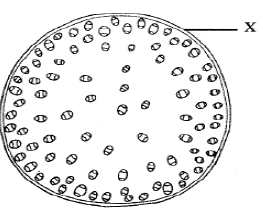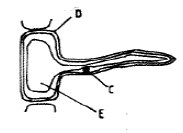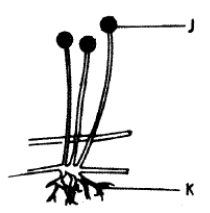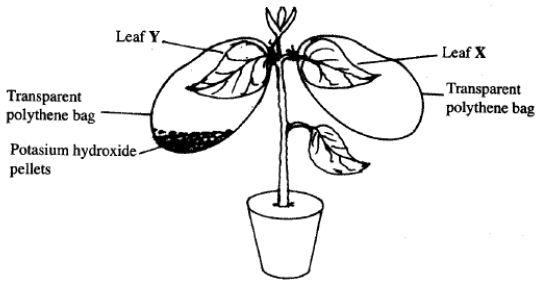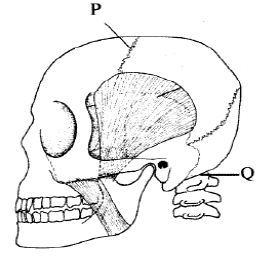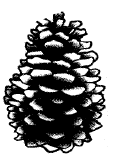QUESTIONS
- State the name given to the study of:
- The cell (1 mark)
- Micro-organisms (1 mark)
- The diagram below shows a transverse section of a plant organ.
- Name the plant organ from which the section was obtained. (1 mark)
- Name the class to which the section was obtained. (1 mark)
- Give a reason for your answer in (b)(i) above. (1 mark)
- Name the part labeled X. (1 mark)
- Name the plant organ from which the section was obtained. (1 mark)
- Name the functions of:
- Ribosomes; (1 mark)
- Lysosomes. (1 mark)
- The diagram below shows a specialized plant cell.
- Name the cell. (1 mark)
- Name the parts labeled D and E. (2 marks)
- State the function of the part labeled C. (1 mark)
- State three ways in which a respiratory surface is adapted to its function. (3 marks)
- State one function of the following:
- Cerebellum; (1 mark)
- Medulla oblongata (1 mark)
- Distinguish between haemolysis and plasmolysis. (2 marks)
- State three external differences between chilopoda and diplopoda. (3 marks)
- State two ways in which chloroplasts are adapted to their function. (2 marks)
- State two advantages of hybrid vigour, (2 marks)
- The diagram below shows a transverse section of a leaf.
- Name the habitat of the plant to which the leaf was obtained. (1 mark)
- Give two reasons for your answer in (a) above. (2 marks)
- Name the habitat of the plant to which the leaf was obtained. (1 mark)
- The diagram below illustrates the structure of a bread mould.
- Name the part labeled J. (1 mark)
- State the functions of the structure labeled K. (2 marks)
- Name the part labeled J. (1 mark)
- What is meant by the following terms?
- Habitat; (1 mark)
- Ecosystem. (1 mark)
- Explain why it is not advisable to be in a poorly ventilated room with a burning charcoal stove. (3 marks)
- A potted plant was kept in the dark for 48 hours. Two leaves X and Y were treated as shown in the diagram below.
The experimental set-up was kept in sunlight for 6 hours after which a starch test was carried out on the two leaves.- What were the results of the starch on the leaves X and Y? (2 marks)
- Give a reason for your answers in (a) above. (2 marks)
- What were the results of the starch on the leaves X and Y? (2 marks)
- What is the role of bile salts in digestion in humans? (2 marks)
- The following is the dental formula of a certain mammal:
- State the likely mode of feeding of the mammal. (1 mark)
- Give a reason for your answer in (a) above. (2 marks)
- State the likely mode of feeding of the mammal. (1 mark)
- Give two reasons why animals have specialized organs for excretion as compared to plants. (2 marks)
- State the changes that occur in the arterioles in the human skin during thermoregulation. (2 marks)
- State two advantages of internal fertilization in humans. (2 marks)
- The diagram below represents part of the human skeleton.
- Name the part labeled P. (1 mark)
- Name the bone that articulates with the part labeled Q. (1 mark)
- What type of joint is formed between the parts labeled Q on the bone named in (b) (i) above? (1 mark)
- Name the part labeled P. (1 mark)
- What is the function of the following structures in the human reproductive organs?
- Fallopian tubes; (1 mark)
- Epididymis; (1 mark)
- Scrotal sac. (1 mark)
- Explain three ways in which the red blood cells are adapted to their function. (3 marks)
- State two ideas proposed by Lamark in his theory of evolution. (2 marks)
- Why is Lamark’s theory not acceptable? (1 mark)
- State three factors that contribute to the deceleration phase in the population curve of an organism. (3 marks)
- State one survival value for each of the following plants:
- Thigmotropism in stems; (1 mark)
- Geotropism in roots; (1 mark)
- What is meant by the term non-disjunction? (1 mark)
- Give the example of a genetic disorder caused by:
- non-disjunction (1 mark)
- gene mutation (1 mark)
- State three structural differences between arteries and veins. (3 marks)
- The diagram below represents a female cone.
- Name the sub-division of the plant from which the cone was obtained. (1 mark)
- Other than the presence of cones, name two other external features that identify plants in the subdivision named in (a) above. (2 marks)
- Name the sub-division of the plant from which the cone was obtained. (1 mark)
- What is meant by the term apical dominance? (3 marks)
Marking Sheme
-
- Cytology: Rej cell biology
- Microbiology
-
- Stem
-
- Monocotyledonae
- Vascular bundles scattered not arranged in a ring;
Absence of pith; Absence of vascular cambium.
- Epidermis
-
- Protein synthesis (Accept: site for protein symbiosis)
- Destroys worn out organelles/cells/tissues
Destroys micro-organisms.
-
-
- Root hair(cell)
- D – cell wall
E – cell sap (vacuole)
- Controls the functioning of the cell/ controls cell activities
-
-
- A large surface area for efficient diffusion of gases
- Moist for gases to diffuse in solution form/to dissolve gases
- Thin for efficient/diffusion of gases (across a short distance)
- Most be close to body cells/well supplied with blood vessel to active cells
- Ventilation mechanism for bringing in air rich in O2 and expelling air rich in carbon(iv) oxide
-
- Maintain balance/posture/control/muscular movement
- Control heart beat/ blood pressure/ breathing(rate) control involuntary activities/ response
Accp. Curved examples of v.a e.g. eating, swallowing e.t.c.
- Haemolysis – process by which red blood cells take in water till they burst; while
Plasmolysis – loss of water from plant cells until the cell membrane is detached from the cell wall/ until the cell become flaccid. -
Chilopoda Diplopoda - A pair of (walking)legs per segment
- Body flattened dosoventrally
- Body divided into head and trunk Acc. Body divided into two body parts
- Posterior genital aperture
- Has poisonous claws
- Have long antennae- 2 pairs of(walking)legs per segment
- Body cylindrical in shape
- Body divided into head thorax and trunk Acc body divided into three body parts
- Anterior genital aperture
- Lacks poisonous claws
- Have short antennae. -
- They contain chlorophyll which traps/absorb light (energy)
- They have grana which increase surface area for accommodation of a large number of chlorophyll molecules for photosynthesis
- The stoma has enzymes for photosynthesis
-
- Resistance to diseases/pests/adverse weather conditions (Acc. Correct examples e.g. drought, very high/ low temperatures
- Increased yields
- Earlier maturity Acc. Early maturity
-
- Aquatic / fresh water
-
- Large air space/aerenchyma
- Sclereids
- Stomata on upper epidermis/absence of stomata in lower epidermis
- Absence of cuticles
- Poorly developed vascular bundles
-
- J – sporangium
-
- Absorption of soluble substances/ digested food
- Secretion of digestive enzymes;
- Anchorage(of mould on substrate); anchorage must be in the right context
-
- Place/environment in which (specified)organism lives
- A natural unit with abiotic and biotic factors
- Charcoal in limited supply of air produces carbon(ii)oxide; which combines with haemoglobin forming carboxyhaemoglobin; which is stable/ does not dissolve reducing capacity of the haemoglobin leading to suffocation/ death;
-
- X – Starch present
Y – Starch absent - X – acts as a control; Y – CO2 absent absorbed by potassium hydroxide pellets; Acc correct explanation
- X – Starch present
- Emulsification / breaking down of fats into (tiny) droplets
Creating alkaline medium for digestive enzymes/ neutralizing acidic chyone (from the stomach) -
- Herbivorous; Rej Harbivores
- Lack canines/ incisors on upper jaws
- Animal form waste products more rapidly than plants/ Produce more metabolic wastes
Animals don’t reuse their waste while plans reuse some of their wastes; - When temperature is high they dilate; when low they constrict (Acc. Vasodilatation)
-
- Higher chances of fertilization
- Embryo/gamete is protected from external environment conditions
-
- P – sutures
-
- Atlas;
- Hinge joint
-
- Passage of ova/ site of fertilization
- Storage of sperms
- Hold the testis/ protect the testis
-
- Absence of nucleus, increase of space for packaging haemoglobin(for carrying oxygen)
- Possession of haemoglobin which has high affinity for oxygen
- Bi-concave shape creates large surface area for combining with oxygen
- Ability to change shape/flexible to enable them pass through capillaries.
- Have carbonic anhydrate which increase CO2 transportation
- Are numerous/many to be able to carry max amount of oxygen
- Has plasma membrane which allow rapid diffusion of gases
-
-
- Use and disuse
- Acquired traits can be passed on to offspring
-
- Acquired characteristics cannot be inherited
- No evidence to support the theory
-
-
- Overcrowding
- Accumulation of toxic wastes
- Limited resources such as nutrients
-
- Provide support
Enables plants to grow forward light - In search of nutrients
Anchorage
- Provide support
-
- Failure of homologous chromosomes to segregate during meiosis/ anaphase I/ meiosis I
Failure of sister chromatid to segregate during meiosis/ anaphase II / meiosis II. -
- Down’s syndrome; Turner’s syndrome; Klinefelter’s syndrome
Surnerz syndrome
Acc. Mongolism for Doran’s syndrome - Albinism; single cell anaemia; heamophilia; colour blindness
Chondrodytrophic dwarfism/ Achondroplasia
- Down’s syndrome; Turner’s syndrome; Klinefelter’s syndrome
- Failure of homologous chromosomes to segregate during meiosis/ anaphase I/ meiosis I
-
- Arteries have thick muscular walls; veins have thin and less muscular walls
- Arteries have narrow lumen, veins have wider lumen
- Arteries have no valves except at junction with heart; veins have valves at regular intervals.
-
- Gymnospermae/ Gymuspermatophyta/ Gymnosperonaphyta;
- Needle-like leaves; thick waxy cuticle
Naked seeds; sunken stomata.
- The inhibition of growth of lateral buds; by auxins; produced by the growing apical bud.
Download KCSE 2010 Biology Paper 1 Questions with Marking Scheme.
Tap Here to Download for 50/-
Get on WhatsApp for 50/-
Why download?
- ✔ To read offline at any time.
- ✔ To Print at your convenience
- ✔ Share Easily with Friends / Students

